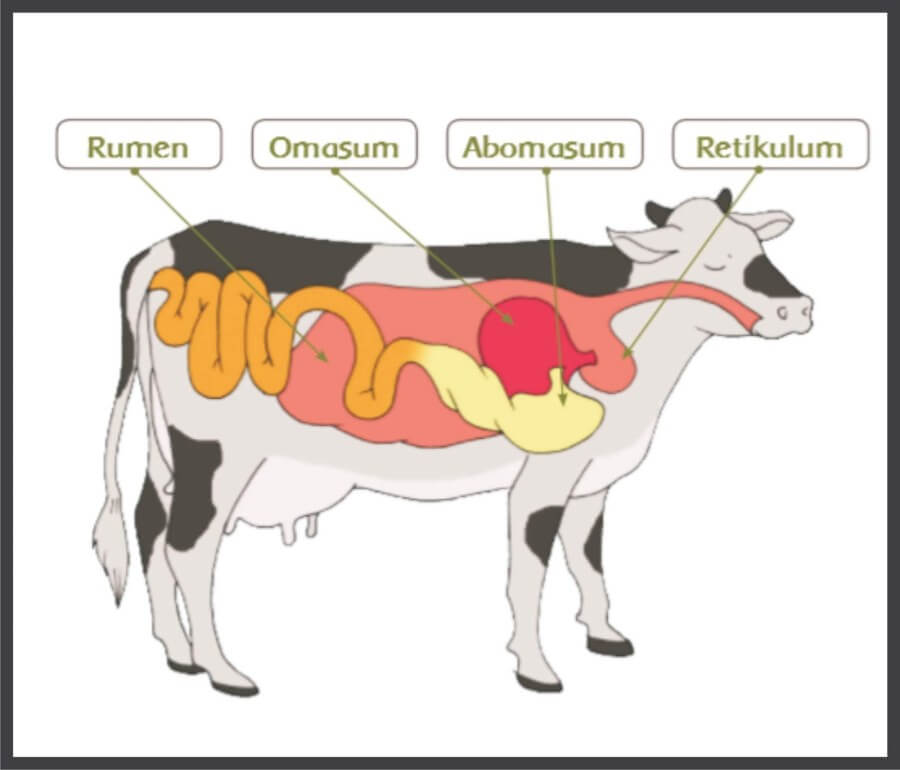
By: Muhammad Tegar K.K., S.Pt
First Expert Livestock Seed Supervisor
Digestive Enzymes in Ruminant Intestines
Anatomically, the small intestine is divided into three parts: duodenum, jejunum, and ileum. The duodenum receives pancreatic juice containing all the digestive enzymes and the site where bile from the liver is stored in the gallbladder. Bile contains essential salts for fat absorption. The jejunum and ileum have long villi to expand the surface area for efficient absorption. The small intestine, particularly the duodenum, is the main site for enzymatic digestion and efficient absorption and distribution (Despal, 2007).
The pH range in the small intestine is 5.5 to 6.4 in calves and higher in adult cattle. A pH value of 7.0 to 8.0 is optimal for pancreatic enzyme activity. In fetal calves (postpartum), optimal enzyme activity in the small intestine is observed with a substantial amount of lactase, cellobiase, maltase, and trehalase. Lactase increases significantly by 50% in calves aged 6 months to a year, while cellobiase and trehalase decrease, and maltase activity remains unchanged (Guilloteau, 2009).
There are three groups of enzymes secreted by the small intestine: carbohydrases, proteases, and lipases.
1. Carbohydrases work on glycosidic linkages between monosaccharide units. α-Amylase hydrolyzes the 1,4-glycosidic linkage in starch and glycogen. Types of carbohydrases include sucrase, maltase, and lactase. Pancreatic amylase is released into the initial part of the small intestine (duodenum), where it continues to digest starch and dextrin into simpler dextrins and maltose.
2. Protease enzymes hydrolyze peptide linkages. Enzymes in this category include pepsin, rennin, trypsin, chymotrypsin, carboxypeptidase, aminopeptidase, and dipeptidase. These enzymes break down proteins and peptides into amino acids.
Pancreatic lipase is secreted by pancreatic juice and hydrolyzes fats into monoglycerides and fatty acids. There's also limited hydrolysis into fatty acids and glycerol. (Despal, 2007).
The pancreas is situated in the duodenal curve, and its fluid is secreted into the duodenum through the pancreatic duct. When acidic substances from the stomach enter the duodenum, the intestinal epithelium releases hormones into the bloodstream. This hormonal response stimulates the pancreas to release a high concentration of bicarbonate ions to neutralize stomach acid. This also triggers another hormone, pancreozymin, secreted by the intestinal mucosa, mainly in response to peptides entering the duodenum, leading to the production of proenzymes and enzymes including trypsinogen, chymotrypsinogen, procarboxypeptidase, alpha-amylase, lipase, lecithinase, and nuclease.
Enterokinase is an enzyme produced by the duodenal mucosa that activates zymogens and inactive trypsinogen into active trypsin, which breaks peptide bonds. The bonds cleaved by this enzyme include those with carboxyl groups of lysine and arginine, and the carboxyl groups of aromatic amino acids. Carboxypeptidase is also activated by trypsin, which cleaves peptide bonds at the terminal ends by releasing amino acids with free carboxyl groups.
Pancreatic lipase is involved in fat hydrolysis. Fats leave the stomach in large globules that are difficult to hydrolyze. However, these large globules are emulsified by bile salts, aiding lipase in hydrolyzing triglycerides into monoglycerides and fatty acids. Lecithin is hydrolyzed by lecithinase into fatty acids, glycerol, H3PO4, and choline.
Nucleic acids, DNA, and RNA are hydrolyzed by polynucleotidase, deoxyribonuclease, and ribonuclease, respectively, into nucleosides and H3PO4. Nucleosides are further hydrolyzed by nucleosidase into purines, pyrimidines, and ribose.
Microflora in Ruminant Intestines
Cellulolytic bacteria are the most abundant bacteria in the intestines, with halophilic bacteria numbering about 110×107 cfu/g and non-halophilic bacteria numbering about 22×107 cfu/g (Hasana, 2015). These bacteria are capable of degrading cellulose, indicating that cattle have the ability to absorb cellulose. This is consistent with the natural conditions of cattle consuming fibrous grasses. Therefore, the presence of cellulolytic bacteria is more prominent.
The second most abundant natural bacteria in the cattle digestive tract are fermentative bacteria, numbering about 85×107 cfu/g of halophilic bacteria and about 26×107 cfu/g of non-halophilic bacteria (Hasana, 2015). The third most abundant natural bacteria in the cattle digestive tract are amylolytic bacteria, numbering about 31×107 cfu/g of halophilic bacteria and about 10×107 cfu/g of non-halophilic bacteria (Hasana, 2015). These bacteria are capable of degrading starch, indicating that cattle have the ability to absorb carbohydrates. The low abundance of amylolytic bacteria suggests that only a small amount of carbohydrates escapes rumen degradation, leading to a small population of amylolytic bacteria.
On the other hand, the least abundant bacteria in cattle digestion are proteolytic bacteria, numbering about 28×107 cfu/g of halophilic bacteria and about 11×107 cfu/g of non-halophilic bacteria (Hasana, 2015). These bacteria have the ability to degrade proteins, but their capacity is not as significant as cellulolytic, amylolytic, and fermentative bacteria. This suggests that the cattle diet contains more fiber than protein and that only a small amount of protein escapes rumen degradation.
References
Despal. 2007. Introduction to Nutrition Science. Department of Nutrition and Feed Technology, IPB. Bogor.
Guilloteau, O., R. Zabielski, J.W. Blum. 2009. Gastrointestinal Tract And Digestion In The Young Ruminant: Ontogenesis, Adaptations, Consequences And Manipulations. Journal Of Physiology And Pharmacology, 60(Suppl 3), 37-46.
Hasana, Uswarul, Nurmiati, Periandi. 2015. Characterization of Natural Microflora in the Digestive Tract of Cattle as Potential Probiotic Candidates for Cattle Feed. Journal of Biology, Andalas University (J. Bio. UA.)



